Palaspas: An Appreciation of Palm Leaf Art in the Philippines
In an increasingly online world, fostering a traditional and tactile art
In an increasingly online world, fostering a traditional and tactile art
Client
Ateneo de Manila University Press
Format
Book
Year
2010
Dimensions
7.75 x 9 in
Ateneo de Manila University Press
Format
Book
Year
2010
Dimensions
7.75 x 9 in

The front cover and spine.
Elmer Nocheseda's book, a product of his lifelong passion, was the perfect opportunity to help present traditional palm weaving to a new generation. The challenge was to combine two disparate parts--academic contextualization and instructional manual--into a cohesive whole. At the same time, the design had to make a "traditional" art more appealing to a contemporary audience whose fingers are perhaps more accustomed to keypads and touch-screens rather than organic art materials.
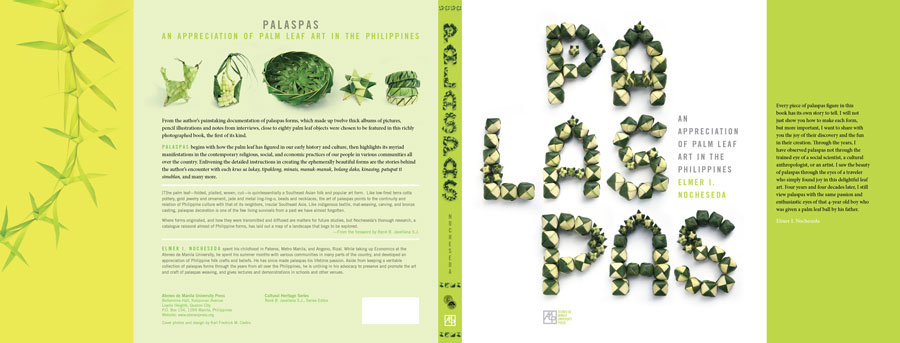
Palaspas cover spread, with french flaps.
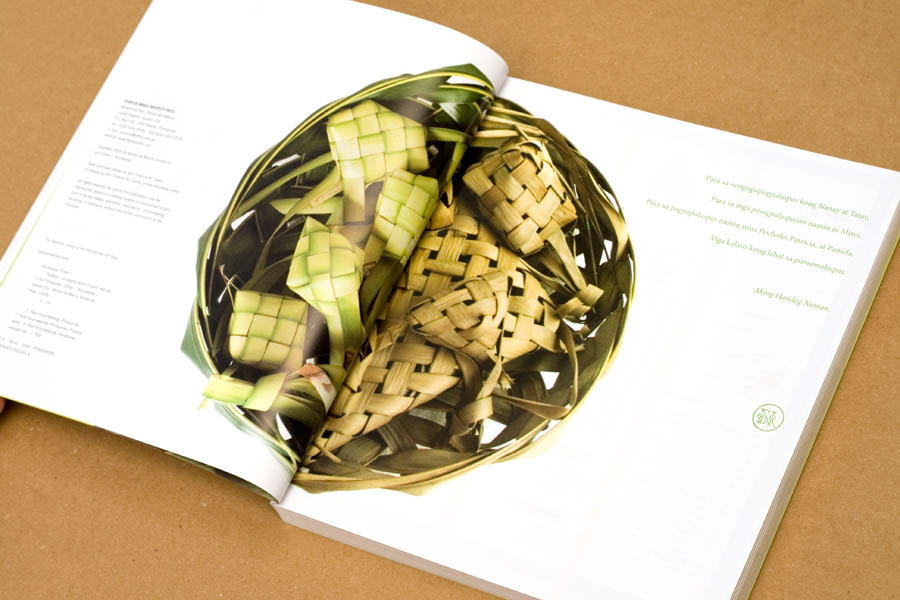
The copyright/dedication page features palaspas forms in a bowl (selingkat) made of palm leaves as well. Fresh on the left side, dried on the right, highlighting the ephemeral nature of the craft.
Publisher's Description
From the author's painstaking documentation of palaspas forms, which made up twelve thick albums of pictures, pencil illustrations and notes from interviews, close to eighty palm leaf objects were chosen to be featured in this richly photographed book, the first of its kind.
Palaspas begins with how the palm leaf has figured in our early history and culture, then highlights its myriad manifestations in the contemporary religious, social, and economic practices of our people in various communities all over the country. Enlivening the detailed instructions in creating the ephemerally beautiful forms are the stories behind the authors encounter with each krus sa lukay, tipaklong, minais, manuk-manuk, bolang dako, kinasing, patupat ti sinublan, and many more.
From the author's painstaking documentation of palaspas forms, which made up twelve thick albums of pictures, pencil illustrations and notes from interviews, close to eighty palm leaf objects were chosen to be featured in this richly photographed book, the first of its kind.
Palaspas begins with how the palm leaf has figured in our early history and culture, then highlights its myriad manifestations in the contemporary religious, social, and economic practices of our people in various communities all over the country. Enlivening the detailed instructions in creating the ephemerally beautiful forms are the stories behind the authors encounter with each krus sa lukay, tipaklong, minais, manuk-manuk, bolang dako, kinasing, patupat ti sinublan, and many more.
Ang disenyo ng isang libro ay dapat na katulad ng disenyo ng isang bahay. May mga bahay na, dahil napakaganda ng disenyo, ay hindi ka na makatulog o makakain o makakilos nang maayos dahil masyado mong hinahangaan ang itsura ng kuwarto, ng pader, ng ilaw, ng mga kung anu-ano. Dapat na tumutulong sa awtor, nagpapakumbaba at hindi nagyayabang ang nagdisenyo ng isang libro. Sa librong nanalo sa taong ito, tumutulong ang disenyo na maintindihan ng mambabasa kung paano gagawin ang nais ng awtor na gawin niya. Malinaw na pinili ang uri, laki, at kulay ng mga letra, ang ayos ng mga litrato, ang uri at bigat ng papel, ang laki mismo ng libro, at ang ilalagay sa cover dahil hinahatid ng mga ito ang mensahe ng awtor. Dahil masining ang pinapaksa ng libro, ang materyal na hawak ng mambabasa ay masining rin. Sa madaling salita, bagay at nakaaambag ang disenyo sa nilalaman ng libro.
From the citation, 29th Philippine National Book Awards13 November 2010

The book's inside covers feature full-color images highlighting the craft's transience. The inside front cover shows the woven forms fresh...
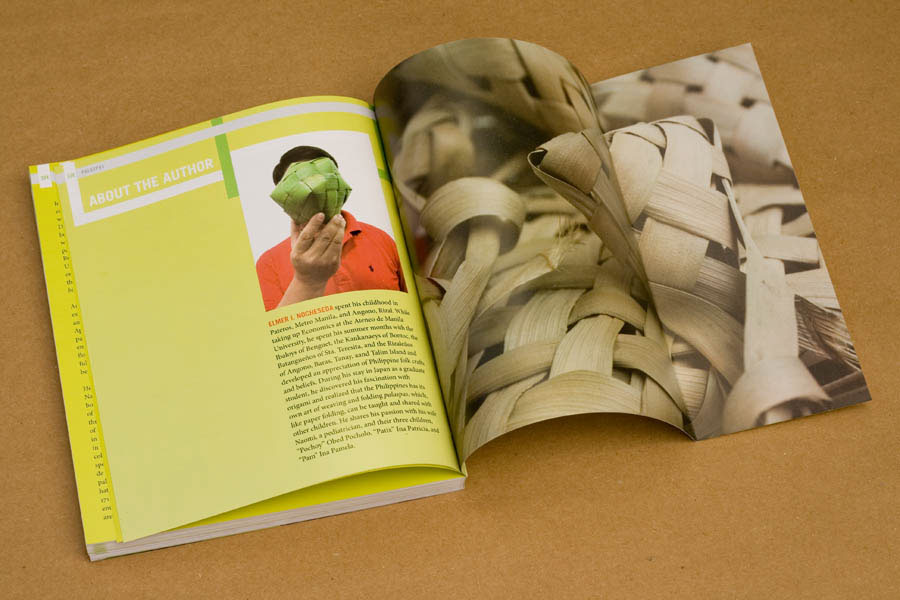
...while the inside back cover shows the same woven pieces dried.
[T]he palm leaf--folded, plaited, woven, cut--is quintessentially a Southeast Asian folk and popular art form. Like low-fired terra cotta pottery, gold jewelry and ornament, jade and metal ling-ling-o, beads and necklaces, the art of palaspas points to the continuity and relation of Philippine culture with that of its neighbors, insular Southeast Asia. Like indigenous textile, mat-weaving, carving, and bronze casting, palaspas decoration is one of the few living survivals from a past we have almost forgotten.
Where forms originated, and how they were transmitted and diffused are matters for future studies, but Nocheseda's thorough research, a catalogue raissoné almost of Philippine forms, has laid out a map of a landscape that begs to be explored.
Where forms originated, and how they were transmitted and diffused are matters for future studies, but Nocheseda's thorough research, a catalogue raissoné almost of Philippine forms, has laid out a map of a landscape that begs to be explored.
From the foreword by René B. Javellana S.J.
Part I: Context

Sample chapter opener for the book's first part, featuring the graphic weave element. Chapter titles are woven into the design, playfully interacting with photos, body text and the folio line.
The graphic weave element refers to the weaving process integral to the craft. Used throughout the book in bright gradations of green and yellow (typical palm leaf colors), the weave element unifies the book's different sections, and gives the traditional craft a younger, more current appeal.
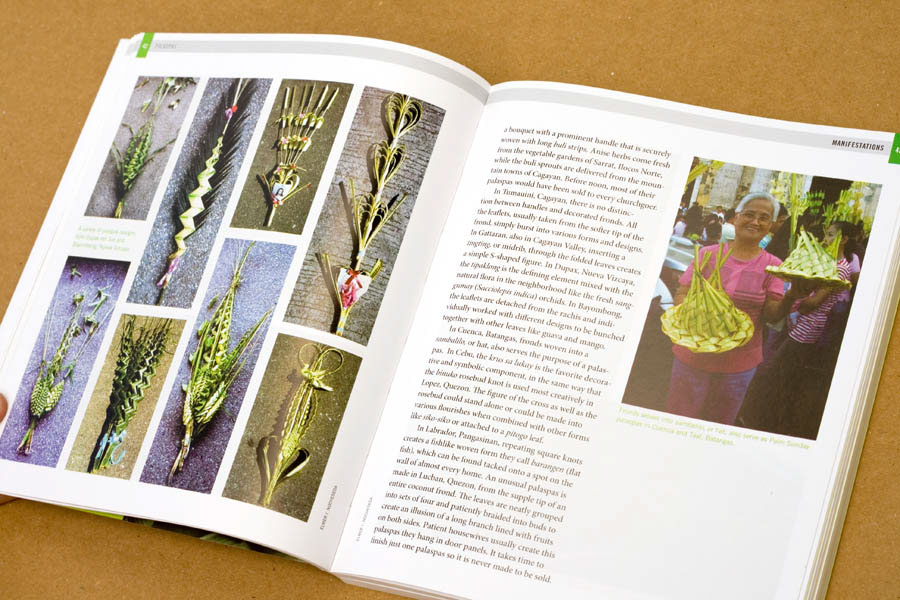

Sample spreads.
Part II: Projects
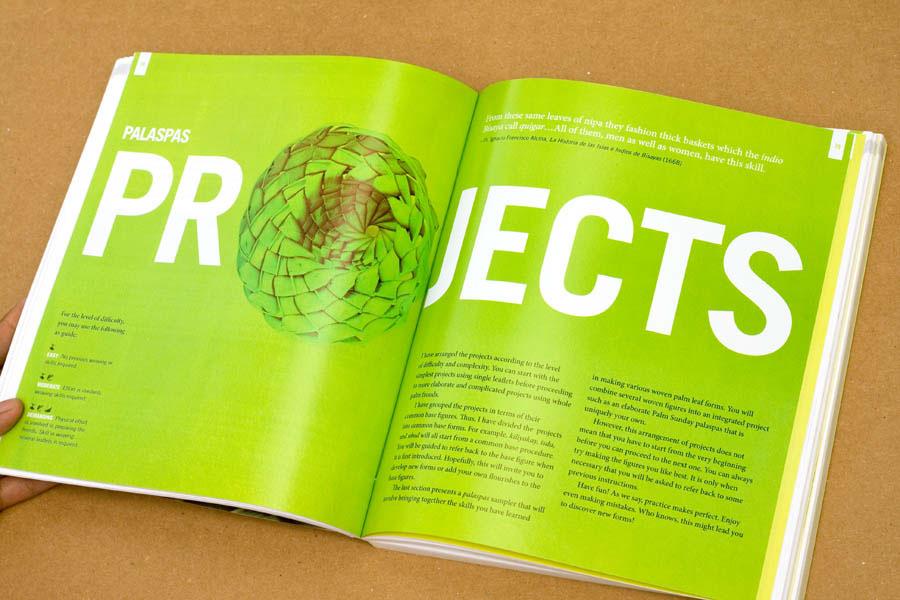
The main divider for Part II, integrating image with type.
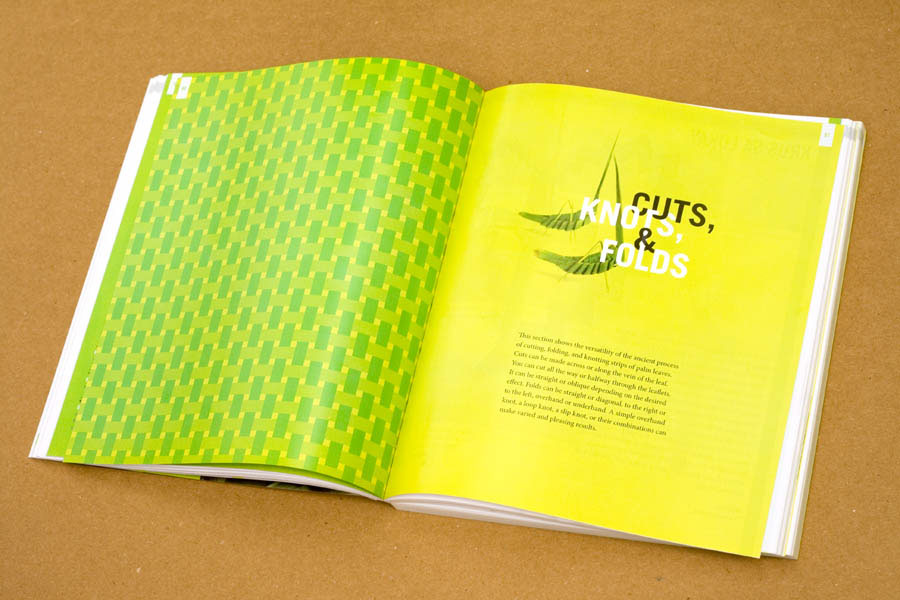
Subsection dividers for Part II, featuring the graphic weave element (left) and the "woven" titles featuring interlocked letterforms.


Sample spreads, featuring step-by-step instructions.

The folio line connects with the graphic weave. For each subsection, the page numbers' shade of green changes subtly.

The back cover.
This book preserves and elevates the art of palm leaf weaving... Beautifully designed and put together by both the author and its book designer, it comes together seamlessly.
Spot.ph
The 10 Best Pinoy Books of 2010 You Should Read—and Give Away
Spot.ph
The 10 Best Pinoy Books of 2010 You Should Read—and Give Away

Not only did I design the book, but I also committed to photographing it, from each step in the instructions to the final product shots. All photos were shot in a makeshift studio in our garage, using mostly available light. More than a thousand photos were taken for the 80 projects featured in the book.
Recognition
Winner
Philippine National Book Awards 2010
Design Category
Black Trophy
Philippine Graphic Design Awards 2010
Bound Pieces Category
Cardinal Sin Book Award for Emerging Author
(Elmer Nocheseda)
Catholic Mass Media Awards 2010
Winner
Gintong Aklat Awards 2010
Arts and Culture Category
Palaspas is available at selected bookstores in the Philippines, and online through the Ateneo de Manila University Press.
Winner
Philippine National Book Awards 2010
Design Category
Black Trophy
Philippine Graphic Design Awards 2010
Bound Pieces Category
Cardinal Sin Book Award for Emerging Author
(Elmer Nocheseda)
Catholic Mass Media Awards 2010
Winner
Gintong Aklat Awards 2010
Arts and Culture Category
Palaspas is available at selected bookstores in the Philippines, and online through the Ateneo de Manila University Press.
